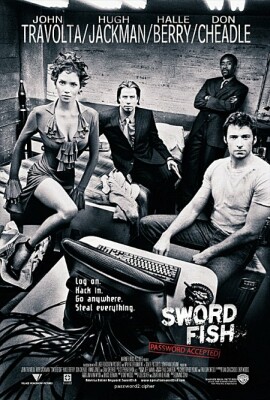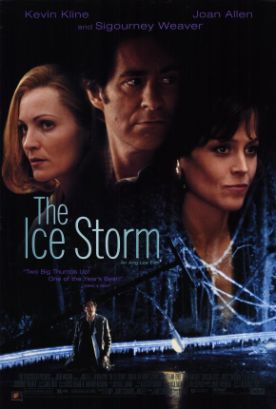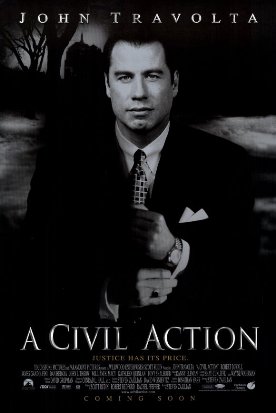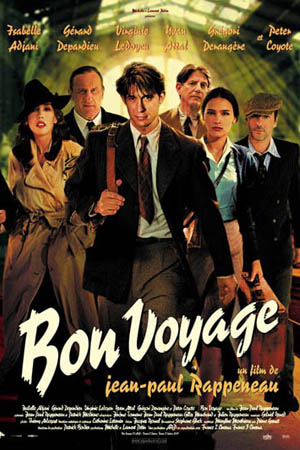Swordfish
As an example of postmodern movie-making, the beginning of Swordfish,
written by Skip Woods and directed by Dominic Sena, takes a lot of beating. John
Travolta looking like the middle-aged dandy of which he has made rather a
speciality since Pulp Fiction, is shown in tight close-up in the role of
movie critic. “You know what the
trouble with Hollywood is?” he asks an interviewer
who is off-camera. “They make
s***.” This uncontroversial
observation he then proceeds to gloss by saying:
“I’m talking about the lack of
realism,” and he cites as his example
the ending of Dog Day Afternoon. Al
Pacino’s character, he thinks,
“didn’t push the
envelope” of what he professes to
think of as realistic movie-making.
“What if he started killing hostages
right away?” he asks.
“How many innocent victims splattered
across the windows would it take to make the city change its
policy?”
The unseen interlocutor, supposedly sticking up for movie conventions, points
out that the hostage crisis could not be seen to be resolved in this way.
“The guy can’t win. It’s a morality
tale. He’s got to go down.”
Travolta’s character then wryly
observes that “life is stranger than
fiction sometimes” before announcing
that it’s time for him to
go — whereupon the camera pulls back to
reveal that he is the chief actor in a hostage-taking that swiftly culminates in
an innocent victim’s being splattered
across the windows.
But the multiple ironies of the scene go further than perhaps the filmmakers
intended. We can pretty confidently expect that the ending of this movie
will not be “a morality
tale” — at least not the traditional
sort exemplified by Dog Day Afternoon. But the appeal to
“realism” — by
which the speaker means that outside of the movies not only do ruthless villains
neglect to build up suspense but crime actually does
pay — is wonderfully double-edged. For
by fracturing what are by now long out-dated movie conventions,
Sena’s movie produces not more but
less realism. Real hostage-takers are more like the muddled and pathetic
character portrayed by Mr Pacino than the machine-like and omnicompetent Gabriel
Shear presented to us by Mr Travolta. And they rarely if ever escape scot-free
with the girl and the money.
Nor does this film’s unrealism stop
here. One is so used to it by now, of course, that
Hollywood’s ignorance of and contempt
for politics and the real exercise of power is easily taken for granted, but
Swordfish takes it to new heights. The terrible Mr Shear, we learn, is an
anti-terrorist terrorist. The bank heist in which he kills several hostages and
police— which, by the way, makes no
dramatic sense, as the money is somewhere else and being shifted around by
computer — is to raise the funds for a
world-wide anti-terrorism campaign being secretly backed by a United States
senator (Sam Shepard) who has, apparently, unlimited use of the federal
law-enforcement apparatus to pursue his clandestine campaign. When Shear, the
senator’s
“rottweiler,”
threatens to get out of hand, he orders him killed. But the quarry turns hunter
when, after murdering a large number of federal agents in black SUVs in the
streets of Los Angeles, he shoots the senator himself in a trout-stream while
proclaiming that “patriotism does not
have a four-year shelf-life.”
These guys don’t even know that
senators serve six-year terms! But to criticize the preposterousness, not to say
the idiocy, of such a plot is, I realize, beside the point, since po-mo
movie-making positively glories in preposterousness. As it does also, obviously,
in eating its cake and having it too by making its ruthless slaughterer of
innocents a right-wing law-enforcement nut. Similarly, it loves the sentimental
cliché of having its hero, played by Hugh Jackman, motivated to help
Shear’s scheme by concern for his
beloved daughter, whom he is forbidden by law to see and whose new step-father
is a porn baron who casts his wife, the
girl’s mother, in his films. Well I
guess we know whose side to be on! But the hordes of people who have made this
the number one movie in the country presumably reason that the unbelievable plot
and the implausible characters are insignificant considerations when put next to
the exciting action photography and the snappy dialogue.
It’s not real but
it’s clever.
Well, there’s no accounting for
taste. But it is just worth pointing to one reason why such a calculation might
be mistaken. A key plot element in Swordfish has to do with illusionism.
Shear explains that he will be able to fool the feds by misdirection, a
magician’s trick perfected by Harry
Houdini. “What the eyes see and the
ears hear, the mind believes.” But
there is an essential difference between magic tricks and movies. With magic
tricks we are content not to know how the trick works. Or at least our enjoyment
of the trick doesn’t depend on our
knowing how it works. But that is because the trick takes place in the context
of reality which, we know, places limits on what is possible. But movies take
place in the context of illusion. And where all is illusion, we have to have a
sense of some underlying reality for any particular illusion to have a pleasing
effect. At the film’s climax, we seem
to see two people killed who are not killed. How did they perform this trick?
The film thinks we don’t need to know,
but I think we do. Otherwise, Hollywood is just making more s***.
Discover more from James Bowman
Subscribe to get the latest posts to your email.







